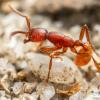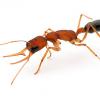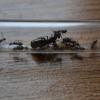Let's compare that to the current Coronavirus crisis. We know a lot about the mortality rate, the rate new people are infected on a daily basis, etc. So we have a lot of data to estimate the danger. But do you really think people would accept a lockdown if we hadn't that data? I don't think so. Myrmecologists demand to not release native ants, because it might be dangerous, not keep non-native ants because it might be dangerous, etc. but what data do they provide to substantiate their claims.
That's a dumb comparison. We know a lot about a how pandemics develop due to our experience with seasonal influenza epidemics, the spanish flu, brid flu, swine flu, SARS, MERS and measles outbreaks (which mostly happen because people are too dumb to vaccinate their kids these days). Most of the data used for this analysis doesn't come from Covid-19 experiences at all but is just the known traits of the current Corona virus applied to our well-developed pandemic spread templates.
We have no complete data on how many people would actually die if we didn't have a lockdown imposed (although we might still get that data as there's a few red states that still haven't done lockdown orders), it's all based on a partial analysis (mostly data from China and South Korea) and our pre-existing knowledge of how pandemics spread and that lockdowns DO actually work (because those actually happened during the spanish flu and MERS and there's solid data about death rates for both).
We already knew how dangerous a pandemic virus can be from our experience with OTHER pandemics, just as we know how dangerous invasive ants can be from our experience with OTHER invasive organisms (and actually even invasive ants themselves).
The findings suggest the released captive Monarchs are less fit, demonstrating a myriad of physical differences from their wild counterparts, and that they are less successful in migration.
I don't think migratory flying solitairy insects are even remotely comparable to non-migratory eusocial insects. Obviously captive-bred insects will have a lesser overall fitness than wild populations (because giving them ideal conditions is part of the project, natural selection is mostly turned off) but we still have no idea how migration in insects even works - obviously their parents can't teach them anything (because they're dead) so it has to be something that's triggered by genetics (or even worse, epicgenetics).
This gets even more complicated when a species cannot complete it's migration cycle within a generation but requires three generations to do so. There could be a generation that is basically unable to migrate (or cannot migrate any other part of the route than the one it is supposed to) and if you raise that one and try to get it to migrate (or to travel a part of the route it normally doesn't due to being the wrong generation), well, that's obviously setting things up for failure.
We do know ants can adapt to different conditions (like Pheidole having more soldiers in the presence of Solenopsis invicta colonies or some species even raising their lost 3rd "supersoldier" caste due to an overwhelming availabilty of high protein junk food) so they're likely much more adaptable than solitairy migratory butterflies or moths. Generally butterflies require much more luck to become invasive anyway as their larval stages are often hyperspecialized to eat one species of plant and one species of plant only, whereas ants usually are generalists that eat a broad variety of insects or plants (in case of leafcutters) and usually don't care what kind of aphid, leafhopper, stinkbug or catterpillar (3d-printed feeder) supplies them with sugars either.
I mean there is a chance that I get struck by a meteoroid when I leave my house. So should I only leave my house wearing a helmet?
That's not even remotely a fitting comparison and also a super self-centered way of thinking about the environment. An ant becoming invasive doesn't just affect YOU, in fact it may not affect YOU at all - but it can smash the entire ecosystem around you leading to long term consequences YOU won't even have to deal with in YOUR life. You're just screwing up the land for everyone who comes after you.
Yes, most ant species do not get invasive if set free and even less do actually become a problem. The problem is what happens IF they manage to become invasive and start to dominate any ecoystem. There are areas in Canada where Myrmica rubra makes up 99.99% of the entire ant fauna, having driven all native ants into complete extinction. We cannot even begin to tell what kind of long term consequences this will have for other animal groups like spiders (which are often greatly reduced in areas dominated by predatory ants), tree pests and in the end even the woods themselves.
There are enough expamples where are a SINGLE predator species managed to completely change the entire composition of an ecosystem, like brown tree snakes on Guam (where the complete eradication of birds on the island has not just caused the spider populations to explode turning the woods into a glimmering sea of silk but is also fundamentally destroying the woodland ecosystem itself as the trees can no longer disperse their seeds due to the utter lack of birds leading to increased erosion and hillside biomes becoming permanently uninhabitable for native plants and animals) or the european wasps in New Zealand (which by drinking all the nectar from tree aphids made entire honeywood ecosystems collapse within a few years, leading to massive extinction events for insects, fungi, reptiles and birds that relied on that honeydew for their survival).
Dumping an exotic ant species into the wild is more like building a nuclear powerplant in your backyard - it probably won't ever suffer a meltdown but IF it does it will make the entire area uninhabitable for most of the currently present animals. Actually, it is worse than that because not even a nuclear explosion can permanently change the fundamental composition of an entire ecosystem - an invasive species can.
We DO have data for that, it may not be always be ants (though in some cases it is, looking at you Anoplolepis gracilipes and Pheidole megacephala) but the devastating and PERMANENT, IRREVERSIBLE damage imported plants and animals can do to ecosystems is VERY well documented in countless instances.
And as long as we don't have an absolutely unfailable knowledge of which species can become invasive in a certain biome and which can't releasing ANY kind of exotic animal is essentially playing a game of russian roulette using a revolver loaded with a Pandora's Box worse than a strategic nuclear warhead. You may hear a click most of the time but if you don't you're looking at the potential complete and utter long-term destruction of your existing ecosystem. And there is no way to restore it to it's original state - once it's gone it's lost forever and it won't come back.






















